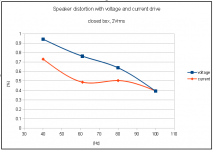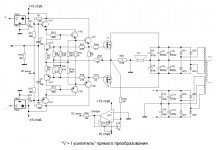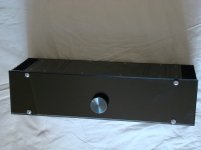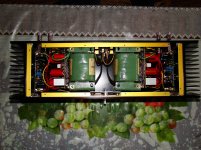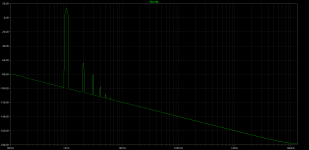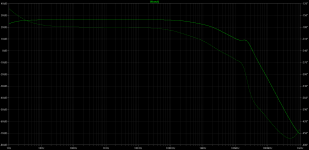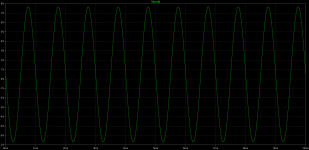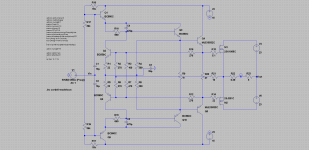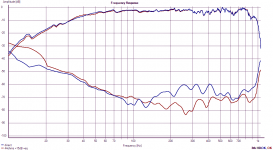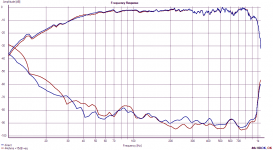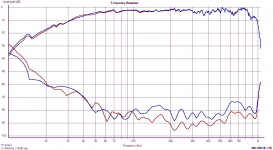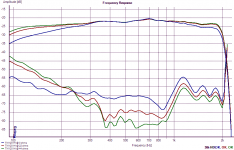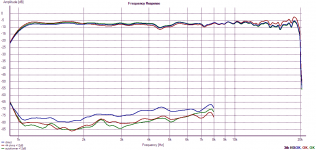Pavel, this is excellent work.
My own investigations in the 1980's & early 90's show similar results but I'd expect improvement even above 100Hz on most speakers
Last edited:
Pavel, this is excellent work.
My own investigations in the 1980's & early 90's show similar results but I'd expect improvement even above 100Hz on most speakers
Thank you Richard, I believe that measurement with a driver without passive crossover (3-way box) would show improvement even above 100Hz, I am planning to make more measurements.
My experiments were with a single drive unit in sealed box.Thank you Richard, I believe that measurement with a driver without passive crossover (3-way box) would show improvement even above 100Hz, I am planning to make more measurements.
For ported boxes, other techniques are better for distortion reduction[*]. I've tried Erik Stahl's ACE with good results. This method is also good for sealed boxes. It's much more complicated
AES E-Library Synthesis of Loudspeaker Mechanical Parameters by Electrical Means: A new Method for Controlling Low-Frequency Loudspeaker Behaviour
[*]Current Drive is poor for ported boxes on several fronts. In particular, the frequency response becomes seriously wonky.
Here are the results I got with midwoofers: http://www.diyaudio.com/forums/vendors-bazaar/190434-hypex-ncore-403.html#post3026510
Last edited:
A moment of doubt...
I have been following this thread with interest. But now some doubts! Of course it is easy to be skeptical (I excel at it!) but here goes:
If current drive (or related ideas like negative impedance) is such a good idea, why has it not been experimented with and developed more fully?
The simplest answer I know is that it would complicate the design of a specific amplifer/speaker combination. Apparently each system must be tuned uniquely.
Does this type of feedback actually reduce distortion or improve the sound in an audible, or at least measurable way?
"Yes", according to some of the data posted here and other places. On the other hand, there are people who say it makes no difference and may even sound worse.
Despite all these doubts, I say "experiment as much as you like!" and I am slightly jealous that I don't have the equipment or the skills to join you.
P.S. My criticism notwithstanding, I have just ordered Meriläinen's book
I have been following this thread with interest. But now some doubts! Of course it is easy to be skeptical (I excel at it!) but here goes:
If current drive (or related ideas like negative impedance) is such a good idea, why has it not been experimented with and developed more fully?
The simplest answer I know is that it would complicate the design of a specific amplifer/speaker combination. Apparently each system must be tuned uniquely.
Does this type of feedback actually reduce distortion or improve the sound in an audible, or at least measurable way?
"Yes", according to some of the data posted here and other places. On the other hand, there are people who say it makes no difference and may even sound worse.
Despite all these doubts, I say "experiment as much as you like!" and I am slightly jealous that I don't have the equipment or the skills to join you.
P.S. My criticism notwithstanding, I have just ordered Meriläinen's book
Last edited:
In France, my own findings (*), comparing voltage and current drive (inserting a resistor of a few tens of Ohm) at different frequencies with equal voltages across the voice coil to maintain identical SPL output, have shown a great disparity in the results. In no way, demonstrate systematic distortion reduction using current drive and often quite the contrary.
(*) Commande en courant des haut-parleurs
there are other investigations made by some fellows in the following posts, their conclusions do not differ from mine.
Speaker Dave shared his experience of current drive in some DiyAudio posts,
non exhaustively :
http://www.diyaudio.com/forums/mult...ing-louspeaker-driver-what-2.html#post2430629
http://www.diyaudio.com/forums/mult...ing-louspeaker-driver-what-3.html#post2432756
http://www.diyaudio.com/forums/mult...ing-louspeaker-driver-what-6.html#post2465501
So if you intend to go current drive, you have to first check if the loudspeaker you're going to use will really benefit from it.
(*) Commande en courant des haut-parleurs
there are other investigations made by some fellows in the following posts, their conclusions do not differ from mine.
Speaker Dave shared his experience of current drive in some DiyAudio posts,
non exhaustively :
http://www.diyaudio.com/forums/mult...ing-louspeaker-driver-what-2.html#post2430629
http://www.diyaudio.com/forums/mult...ing-louspeaker-driver-what-3.html#post2432756
http://www.diyaudio.com/forums/mult...ing-louspeaker-driver-what-6.html#post2465501
So if you intend to go current drive, you have to first check if the loudspeaker you're going to use will really benefit from it.
sims
I simulated this amp
and the results are very good!
attached pics and asc file for playing.
With the transistors I used it needed to calm it but still ~20MHz knee exists...
I simulated this amp
and the results are very good!
attached pics and asc file for playing.
With the transistors I used it needed to calm it but still ~20MHz knee exists...
Attachments
In France, my own findings (*), comparing voltage and current drive (inserting a resistor of a few tens of Ohm) at different frequencies with equal voltages across the voice coil to maintain identical SPL output, have shown a great disparity in the results. In no way, demonstrate systematic distortion reduction using current drive and often quite the contrary.
I have found the only consistent and notable improvement (distortion reduction at acoustical side), with current drive, for woofers in closed box, below 100Hz. With midrange drivers and tweeters, there was almost no difference between voltage drive and current drive. Plenty of measurements were done in last weeks.
Current drive of speakers and speaker distortion
Proudove buzeni repro a zkresleni repro
I found quite the opposite regarding woofers: the midband odd order distortion was much reduced whereas the low frequency distortion (mechanical) was not.
With current drive you could more clearly see a trend where the disotrtion was slowly rising when going down in frequency, as if the "distortion floor" was lower in midband.
You will find attached the 3rd, 4th and 5th distortion measurement of a TAD TL1801 18" driver in a 230L closed box.
Blue is voltage drive, red is with a 44 ohms series resistor, with EQ and gain matching to get the almost exact same response (a big notch around the resonant frequency was applied...).
With current drive you could more clearly see a trend where the disotrtion was slowly rising when going down in frequency, as if the "distortion floor" was lower in midband.
You will find attached the 3rd, 4th and 5th distortion measurement of a TAD TL1801 18" driver in a 230L closed box.
Blue is voltage drive, red is with a 44 ohms series resistor, with EQ and gain matching to get the almost exact same response (a big notch around the resonant frequency was applied...).
Attachments
Last edited:
Now with a TM1201H mid woofer, with 0, 22 and 44 ohms in series.
No EQ this time, so the rising in distortion down low is simply due to the rising in response level (that was verified, but I have no measurement)
No EQ this time, so the rising in distortion down low is simply due to the rising in response level (that was verified, but I have no measurement)
Attachments
Last edited:
And now with a compression driver.
Here there is no gain in distortion from the current drive per se: the same reduction can be obtained by simply reducing the gain at the output of the amplifier (and of course increasing input level to get a matched SPL) with an autoformer used as a lpad
So this distortion comes from the amplifier (this was nbot the case for the woofer measurements).
blue: voltage drive
green: voltage drive with a lpad on the output and +12dB of gain to match output level
red: 44 ohms series resistor and +12dB of gain to match output level (no EQ)
Here there is no gain in distortion from the current drive per se: the same reduction can be obtained by simply reducing the gain at the output of the amplifier (and of course increasing input level to get a matched SPL) with an autoformer used as a lpad
So this distortion comes from the amplifier (this was nbot the case for the woofer measurements).
blue: voltage drive
green: voltage drive with a lpad on the output and +12dB of gain to match output level
red: 44 ohms series resistor and +12dB of gain to match output level (no EQ)
Attachments
Last edited:
- Home
- Amplifiers
- Solid State
- Current drive for Loudspeakers
